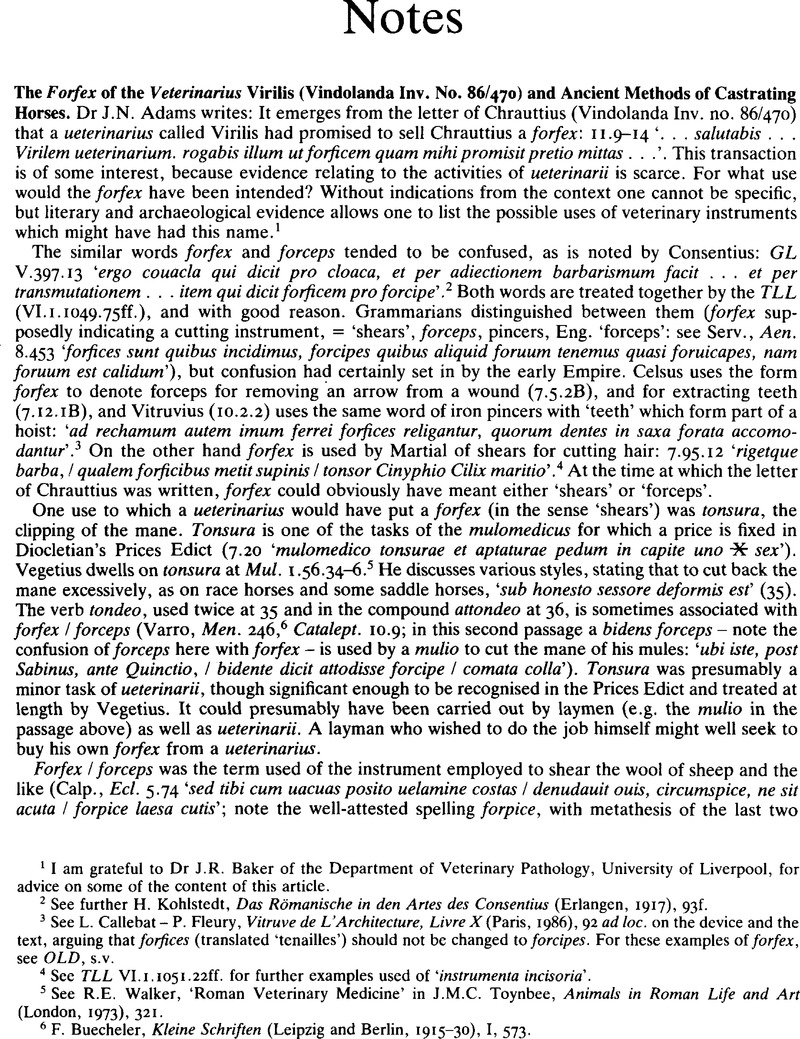Article contents
The Forfex of the Veterinarius Virilis (Vindolanda Inv. No. 86/470) and Ancient Methods of Castrating Horses.
Published online by Cambridge University Press: 09 November 2011
Abstract

Information
- Type
- Notes
- Information
- Copyright
- Copyright © Dr J.N. Adams 1990. Exclusive Licence to Publish: The Society for the Promotion of Roman Studies
References
1 I am grateful to Dr J.R. Baker of the Department of Veterinary Pathology, University of Liverpool, for advice on some of the content of this article.
2 See further Kohlstedt, H., Das Römanische in den Artes des Consentios (Erlangen, 1917), 93f.Google Scholar
3 See Callebat, L. – Fleury, P., Vitruve de L'Architecture, Livre X (Paris, 1986), 92Google Scholarad loc. on the device and the text, arguing that forfices (translated ‘tenailles’) should not be changed to forcipes. For these examples oiforfex, see OLD, s.v.
4 See TLL VL1.1051.22ff. for further examples used of ‘instrumenta incisoria’.
5 See Walker, R.E., ‘Roman Veterinary Medicine’ in Toynbee, J.M.C., Animals in Roman Life and Art (London, 1973), 321.Google Scholar
6 Buecheler, F., Kleine Schriften (Leipzig and Berlin, 1915–1930), I, 573.Google Scholar
7 See Milne, J.S., Surgical Instruments in Greek and Roman Times (London, 1907), 49Google Scholar, suggesting that it may have been difficult to get a fine enough edge on it.
8 Note the plural: the singular and plural forms are used indifferently: TLL VI. 1.1050.46ff.
9 op. cit. (note 5), 324.
10 See Rolling, A., ‘Römische Kastrierzangen’ Archäologisches Korrespondenzblatt iii (1973), 353ff.Google Scholar, with illustrations; Down, A., Antiqu. Journ. lxii (1982), 368.Google Scholar The first of these articles was drawn to my attention by K.-D. Fischer, the second by M.W. C. Hassall.
11 Note Pliny, Nat. 9.97 ‘denticulatis forcipibus’, of a crab's pincers; a tool which resembled these might well have the same or a similar name. Cf. Nat. 11.97 ‘dentatis forcipibus’, of a beetle.
12 This intransitive usage is not registered in Feltenius, L., Intransitivizations in Latin (Uppsala, 1977).Google Scholar
13 op. cit. (note 5), 333.
14 op. cit. (note 5), 324.
15 The writers are indebted to Mr Evans for allowing us to publish his find which remains in his possession.
- 4
- Cited by

